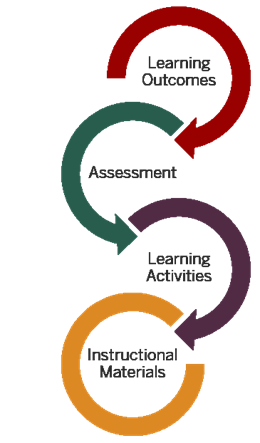Part 2: Starting with a Clear Plan
Beginning with the End in Mind
 When you’re transitioning a course to an online format, it’s important to take a step back and look at it holistically before diving in. Online classes are often more structured than in-person classes so making sure you have a clear and logical structure is important to your students’ success and your own peace of mind.
When you’re transitioning a course to an online format, it’s important to take a step back and look at it holistically before diving in. Online classes are often more structured than in-person classes so making sure you have a clear and logical structure is important to your students’ success and your own peace of mind.
To do this, we’re going to use the backward course design model (Wiggens & McTighe, 2005), very commonly used in all levels of education. Backward course design involves answering three questions:
- What do you want the students to learn?
- How will both you and your students know if they are learning?
- What actions will both you and your students need to take for them to learn?
It’s about beginning with the end in mind. It starts with clearly describing your desired learning outcomes – what you want your students to know and be able to do at the end of the course. From there it “backwards” through assignments to assess how well your students know and can do these things, learning activities to give them opportunities to work with the content and skills, and instructional materials to provide the information and explanations they need to succeed.
Letting your desired learning outcomes lead the course can be challenging if you’ve spent years taking and teaching courses put together based on covering content. A content-centered course starts with a list of topics (not uncommonly based on textbook chapters) and works through them over the semester focusing on covering all the things. Alternatively, a backward design course is learning-centered and begins with the answers to the three questions above.
In the following video, a University of Wisconsin faculty member describes how they are using the backward design process to improve courses.
Alignment is a big deal
The key point of backward design is that your assessments, activities, and instructional materials should all align to your desired outcomes. This makes sure that what you teach, the activities and materials you use to teach, and what knowledge and skills you assess all lead to the same place. And that the place is a destination both you and your students know based on your learning outcomes.
This is where things can get tricky. You have to be really clear about what you want your students to know and be able to do. If you want them to be able to carry out pH tests of water samples, asking them to identify the second step in the process via a multiple-choice question won’t provide the evidence you need. Identifying steps on a quiz will only provide evidence that they remember the steps. If your intended learning outcome is that they conduct the test, they have to physically or digitally conduct the test to prove they can do it.
Alignment is also the cornerstone of the Quality Matters rubric. If you are intending to have your online course formally or informally reviewed against the QM standards, you will need to pay particular attention to the alignment of these items.

